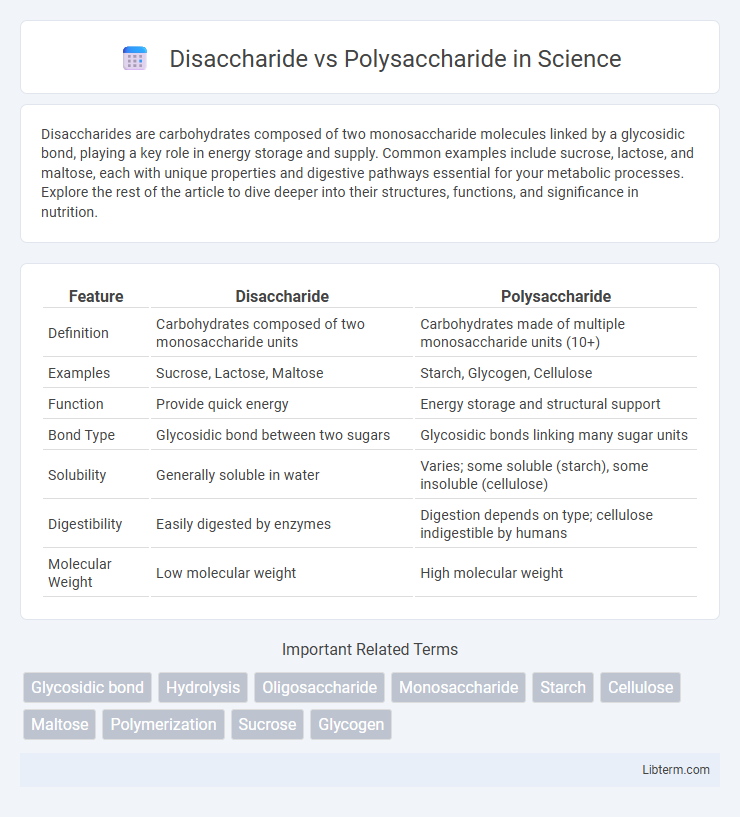Disaccharides are carbohydrates composed of two monosaccharide molecules linked by a glycosidic bond, playing a key role in energy storage and supply. Common examples include sucrose, lactose, and maltose, each with unique properties and digestive pathways essential for your metabolic processes. Explore the rest of the article to dive deeper into their structures, functions, and significance in nutrition.
Table of Comparison
| Feature | Disaccharide | Polysaccharide |
|---|---|---|
| Definition | Carbohydrates composed of two monosaccharide units | Carbohydrates made of multiple monosaccharide units (10+) |
| Examples | Sucrose, Lactose, Maltose | Starch, Glycogen, Cellulose |
| Function | Provide quick energy | Energy storage and structural support |
| Bond Type | Glycosidic bond between two sugars | Glycosidic bonds linking many sugar units |
| Solubility | Generally soluble in water | Varies; some soluble (starch), some insoluble (cellulose) |
| Digestibility | Easily digested by enzymes | Digestion depends on type; cellulose indigestible by humans |
| Molecular Weight | Low molecular weight | High molecular weight |
Introduction to Carbohydrates
Disaccharides are carbohydrates composed of two monosaccharide molecules linked by a glycosidic bond, serving as a key source of energy in the human diet. Polysaccharides consist of long chains of monosaccharides, functioning primarily as energy storage (e.g., starch and glycogen) or structural components (e.g., cellulose) in plants and animals. Carbohydrates, fundamental biomolecules, provide fuel for cellular activities and contribute significantly to metabolic processes.
What are Disaccharides?
Disaccharides are carbohydrates consisting of two monosaccharide molecules linked by a glycosidic bond, such as sucrose, lactose, and maltose. They serve as a quick energy source and undergo enzymatic hydrolysis during digestion to release monosaccharides for absorption. In contrast to polysaccharides, which are complex carbohydrates with long chains of monosaccharide units, disaccharides have simpler structures and faster metabolic processing.
What are Polysaccharides?
Polysaccharides are complex carbohydrates composed of long chains of monosaccharide units linked by glycosidic bonds, serving as energy storage or structural components in organisms. Common examples include starch, glycogen, and cellulose, each differing in their monomer composition and branching patterns, which influence their biological roles. Unlike disaccharides, which consist of only two monosaccharides, polysaccharides can contain hundreds or thousands of sugar units, enabling them to perform diverse functions such as energy storage in plants and animals or providing rigidity to plant cell walls.
Structural Differences
Disaccharides consist of two monosaccharide units linked by a glycosidic bond, typically resulting in a simple, small molecule like sucrose or lactose. Polysaccharides are long chains of monosaccharide units connected by multiple glycosidic linkages, forming complex, high-molecular-weight polymers such as starch, cellulose, or glycogen. The structural complexity and branching in polysaccharides provide diverse functional properties compared to the relatively simple, linear or slightly branched structure of disaccharides.
Chemical Properties Comparison
Disaccharides consist of two monosaccharide units linked by a glycosidic bond, exhibiting moderate solubility and reactivity compared to polysaccharides. Polysaccharides are long chains of monosaccharide units, often branched, with higher molecular weight and reduced solubility, contributing to their structural and storage roles in organisms. The chemical stability of polysaccharides typically exceeds that of disaccharides due to extensive hydrogen bonding and complex molecular architecture.
Biological Functions
Disaccharides such as sucrose and lactose serve primarily as quick energy sources and facilitate carbon transport in plants and animals. Polysaccharides like starch, glycogen, and cellulose provide long-term energy storage, structural support in plant cell walls, and energy reserves in animals. These carbohydrate polymers play critical roles in metabolism, cellular communication, and maintaining organismal energy balance.
Dietary Sources
Disaccharides, such as sucrose, lactose, and maltose, are primarily found in foods like table sugar, milk, and malted products, offering quick energy due to their relatively simple structure. Polysaccharides, including starch and cellulose, are abundant in whole grains, legumes, vegetables, and fiber-rich fruits, providing sustained energy and promoting digestive health. These complex carbohydrates contribute to satiety and help regulate blood sugar levels through gradual digestion and absorption.
Health Implications
Disaccharides, such as sucrose and lactose, are rapidly digested sugars that can cause quick spikes in blood glucose levels, impacting insulin response and increasing the risk of metabolic disorders when consumed in excess. Polysaccharides, particularly complex carbohydrates like cellulose and starch, promote sustained energy release, improve gut health through dietary fiber, and help regulate blood sugar levels. Incorporating polysaccharides into the diet supports long-term metabolic balance and reduces the risk of obesity, diabetes, and cardiovascular diseases compared to high intake of disaccharides.
Digestion and Metabolism
Disaccharides, such as sucrose and lactose, are broken down into monosaccharides by enzymes like sucrase and lactase during digestion, enabling rapid absorption into the bloodstream for immediate energy metabolism. Polysaccharides, including starch and glycogen, require enzymatic hydrolysis by amylase into simpler sugars before cellular uptake, supporting sustained energy release and storage. The metabolic pathways for monosaccharides derived from both disaccharides and polysaccharides converge in glycolysis, facilitating ATP production and maintaining blood glucose homeostasis.
Key Differences at a Glance
Disaccharides consist of two monosaccharide units linked by a glycosidic bond, exemplified by sucrose and lactose, whereas polysaccharides are complex carbohydrates made of long chains of monosaccharide units, such as starch and cellulose. Disaccharides generally function as quick energy sources and are easily digestible, while polysaccharides provide sustained energy and structural support in plants and animals. The molecular weight and complexity of polysaccharides significantly exceed those of disaccharides, influencing their solubility and biological roles.
Disaccharide Infographic

 libterm.com
libterm.com